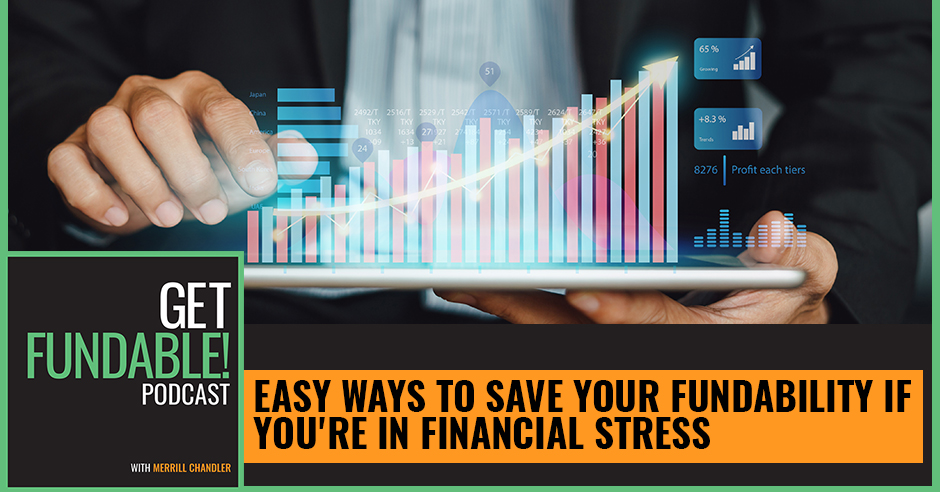
There has never been a more challenging time than now, in our current pandemic, for people with their financials. With so many individuals who are out of jobs, financial stress has become more evident than ever. Helping you not only get out of that ditch, but also recover with a soft landing, Merrill Chandler dedicates this episode to share with you some of the easy ways to save your fundability™. He explains how things can go sideways in recessions and how you can prepare for them to protect yourself. Join Merrill as he takes you deeper into your credit profile, lenders, banks, and even some borrower behaviors throughout this conversation.
—
Watch the episode here:
Listen to the podcast here:
Easy Ways To Save Your Fundability™ If You’re In Financial Stress
In this episode, we’re going to discuss how to create fundability™ and protect yourself. As you read, you will realize that these topics may be very relevant to many of you. In our current pandemic—which is negatively affecting our fundability™ like never before—it’s important to bring up not only how easily things can go sideways, but how you can prepare for that to protect yourself and recover with a soft landing!
—
Our intention with every episode is to shine a light on the path that’s going to lead you to greater and higher funding approvals. One of the main ways that we can continue to be fundable is to protect our credit profile. We need to know what borrower behaviors are important to watch during financially stressful times? And it doesn’t even matter where that stress is coming from, whether it’s a nationwide recession, a job loss, health problems, or a family–sized, individual financial stress. So let’s get into it!
How The Systems Work
Let’s begin with one of the main things that we want to focus on, and also spend a moment reminding ourselves how the system works. Both your borrower profile and borrower behaviors are measured by FICO and lending software to determine if you are fundable. In recessionary and financially stressful times, the lenders only make money when they actually lend. When things get stressful out there, they tighten the funding guidelines so that only a top-tier, bulls-eye borrower who is highly fundable will continue to get approved.
You may have already experienced this if you’ve had high balances for a long time. Let’s say that all of a sudden…you come to money, get reemployed, finish a project, and get paid. But when you start paying down those balances, it’s likely that those lenders are going to start lowering those limits. This will be our starting point today! Our first strategy is about how to protect your limits if you’ve been carrying balances because you were living off them or paying bills off of them, all while you didn’t have the resources to take care of those financial commitments.
Contact Your Lender
The first strategy for maintaining fundability™ during financial stress is about carrying high balances. Before you start paying them down, you want to contact each lender and humbly supplicate them by saying something like, “I value my relationship with you guys. I love this credit card,” or with your main bank, if you have a checking account with them as well, say, “My financial situation has turned around.” You shouldn’t mention that you got re-employed or that you experienced a big wind fall, because those aren’t trustworthy metrics. Just say, “I’ve got my legs under me. I had a bit of a rough patch and so my balances are a little high. I want to start paying those down, but because I love my relationship with you, I want to know what I can do so that you don’t continue to lower the limit as I pay down my balances.”
Lenders only raise limits when they decide to give you limits. Share on XThis will do two important things for you. We want to keep those limits high! When making a payment, many times people come to me and say, “I thought I was doing right by my credit card company. I pay off $1,000, but then all of a sudden, I go from a $10,000 limit and balance on my card to a $9,050 limit.” The difficult factor we need to watch out for is when they lower the limit back down, so that you’re near a 100% utilization rate, the new balance that you pay down to is most of the new credit line, so you’re back to 100% utilization.
You can talk to a supervisor to do so, but you want to convince them that everything is good, and that you want to be given a test or probationary period. I’m going to try to describe this in as much detail as I can…but let’s say you’re sitting on a $10,000 limit with a $9,900 balance. You have used $9,900 of it, which means you’re at 99% utilization. If you come in and we pay it down to $7,000 as our new balance on that $10,000 card, and then they lower it and make the new limit $7,050, now you’re back to 99% utilization. When we contact the lender, we want to be able to say, “I love my relationship with you guys. You’re the bomb! So I acknowledge and apologize for carrying such a high balance for so long. It wasn’t my intention. Now that things are back in play, can I make a payment?” Tell them how much you want to pay…whether it is $1,000, $500, or some other big chunk. And also let them know that you want to be able to keep this balance between $7,000 and $10,000, and that they can put you on probation if you charge even a dime to it between now and three months in the future. They may offer six months, but try to stick with three because it will help you improve your utilization.
Offering A Probation
So let’s say they do in fact accept, and you’re at $7,000. You went from 99%, if they would have lowered it and let you keep it. Now, you’re at 70% utilization. That’s a massive improvement to your fundability™ and you’re showing good faith and goodwill towards your lender as your lending partner. You’re showing them that you’re trying to value their money because you used that whole credit card limit in order to survive. The only thing that’s going to convince them to keep that limit up is if you offer a probation where you don’t use it.
This is our way of going out on a limb. If you ask for it and then end up violating it…that is worse than if you didn’t ask for it at all. So you have to keep your word! This is a very powerful strategy to keep lowering it. Give them a secured and trustworthy plan. For example, “Within 30 days, 3 months, or 6 months, I want to get it down to 50%, or $5,000. Can we do the same thing? I want to pay it down, but I want to keep the limit.” You’ll be at 50% utilization. Remember, for those of you who attended the bootcamp or read my book, anything under 40% is not only our safe spot, but our end game as well. That is where we want to be!

Your Fundability™: The higher the limit within reason, the more fundable you are, especially for entrepreneur clients.
We want to get down to paying it off completely, but until that happens…our main goal is to lower it under 40%. Once we hit that target, we will be out of the risk department. Every moment that you sit above 40% is a liability. These are important measures to take so that you can keep these limits. When they decide to give you limits again, they’ll only consider raising it every six months. Within reason…the higher the limit, the more fundable you are, especially for our entrepreneur clients who want business lines of credit or business loans. Again, during times of stress, our first strategy is talking to the bank before you start lowering that balance through payments.
Now, as we move on to the second strategy…the initial point I want to make is never ever make a minimum payment! This is very harmful because of the fact that you’re basically telling the algorithm that you don’t have any money, and that the minimum is the best you can do. This is the only time that I like using the word “hack.” I usually refrain from saying that when it comes to banking because it doesn’t sound good. But in this case, you can in fact hack the algorithm! If you have a minimum payment of $50, try to instead make a payment of $51, $52, $55, $63, etc. Make the payment a different amount each month, even if it’s only a dollar above the minimum. Yes, this can a pain in the butt…especially if you want it on auto-pay. It might be great for your budget, but you would be telling the lender, through their software, that you can’t afford anything. This will put them on high alert, and they’ll start searching for other negative behaviors that will further prove to them that you’re not a viable borrower as of right now.
If you fail to implement these strategies, the lenders will continue to watch out for you and make it a point to keep you in their risk department. In every way you can…pay something close to the minimum to support your budget, but never make the actual minimum payment. Even if you have to complete the payments manually, it’s still worth it. It’ll help you maintain your fundability™ in these scary times.
The third strategy is all about budgeting, and I’m pulling it straight out of my bootcamp! Your budgets aren’t online, nor are they available to your lender. You want to audit your books, but for two different things. This is one strategy split into two parts, and the first deals with auditing all of your expenses. Let me ask you all this…how many times have you subscribed to something? For example, you download a music app or streaming service, sigh up for that familiar 30-day free trial, but end up forgetting about it! I know I have! This is why you want to pull out the bank statements from all of your accounts and audit every single expense. This is the easiest way to discover the things that you don’t need, but are still spending money on without even realizing it!
Let’s say that you’re re-employed and everything is back on track. The automatic deposits from your employer and the money that you’re putting into your checking account is measured by your lender. We will dive deeper into which balances will help you with your financial stress shortly. But with all that money coming in, there is money simultaneously coming out. Your bank uses their software to measure both the money coming in and the money coming out. And if there isn’t an accumulation in that balance, you’re barely making ends meet. Not only that, but you would be sending that message right to your bank.
And trust me, they’ll remember it. Especially if you try to negotiate it, they might look at your checking account as well. All of this relates back to strategy number one. The bank might be looking at your income and watching it slowly grow so that they can simply decide whether or not they implement that strategy. In this instance, you want to slowly accumulate $50 a month, $100 a month, etc., but it’s essential that you make sure there’s more money going in than there is coming out because the software is actively measuring that. The way we can secure this process is by auditing our books. You should go back at least three months to see what automatic deductions are coming through and determine which items you can live without. As I mention in the bootcamp…each increment—3, 6, 12, or 24 months—contributes more and more to your fundability™. If you remove unnecessary items from your expenses, it will increase your bank balance level. It’s very common, on both your business and personal sides, to forget about certain subscriptions we have that cost us money. With my business, we usually go through our softwares quarterly to assure that we aren’t paying for anything that we don’t need and/or use. Even if you remove it temporarily, it’s still likely to increase the balance in your checking account. So please make sure that you audit for those lost or forgotten items.
Our fourth strategy deals with your checking account. We needed to increase that balance. I will explain this as crystal clear as I can for those of you who are reading. In your checking account, you can’t have a zero balance…not under any circumstance. This is a huge way to improve your fundability™! Many of you received a check guarantee card associated with that checking account. But that card is a credit line and, if it’s used and has a balance on it, there’s $300 on that credit line. And remember…that gets broadcasted to future lenders! Having $300 on your Wells Fargo credit card is no big deal…but $300 on a check guarantee card means that you are past zero. We don’t want to be past or below zero because it shows that this borrower doesn’t have any money. It’s a highly un-fundable message that you do not want to put out there! If you’re going to carry a balance, do it on a credit card that is not your check guarantee because it’s a huge red flag if you are below zero on your checking account.
So how do you account for that balance being raised? By cutting out luxuries, lost or forgotten debits, auto drafts, etc. When I mention building a relationship with your checking account, I’m talking about these magic numbers: 1, 2, 4, and 7…which start at $100, $200, $400, and $700. This is called a bank rating, but I always like to call it a depositor rating because these numbers reveal how valuable of a customer you are to your bank! Your average daily balance needs to be at least $100, $200, $400, or $700.
If you're going to carry a balance, carry it on a credit card. Share on XPicking those thresholds will slowly move your balance up and up…and the higher you are, the more valuable you are to the lender. And it doesn’t stop at $700. As you add more zeros to the end of each number, they can pop up to $1,000, $2,000, $4,000, or $7,000…and then eventually $10,000, $20,000, $40,000, or $70,000. Two zeros at the end of the number is the minimum, making $100 the floor. But again, I feel that it’s necessary to reinforce how essential it is that you stick to those four magic numbers. For example, having $39,000 isn’t more valuable than having $20,000. You want to keep hitting the different thresholds of 1, 2, 4, or 7 for you to be able to establish a valuable relationship. Even if you only reach $100 or $200 at first, I still want you to hit those targets. That minimum daily balance of at least $100 will become the new zero.

Your Fundability™: It is a huge red flag when you are below zero on your checking account.
So, not only are we not using the check guarantee card and sending bad messages there, but we’re also keeping an average daily balance of $100. If I can get you to reach $200, then bravo! If I can get you to $400, even better! Hitting those targets will aid you in building your relationship with your bank. If we’re re-employed, we’re already depositing the checks. Even if they happen to be pension or unemployment checks, you’re still on a fixed income. It doesn’t matter what’s being deposited into your account. We want to keep these minimum balances and average daily balances to add one more set of powerful messages that you can send your lenders, protecting your fundability™ in the process.
Well, there you have it! We covered amazing strategies that will help your checking accounts, credit cards, and lowering your balances without losing your limits. And if you implement them, your value in the eyes of a lender is going to skyrocket…even during stressful times like these! The principles are still true, even if you’re not in financial stress. If you do happen to be in financial stress…my heart goes out to you. I pray and wish for your good fortune to improve! I want you to take care of yourself and your loved ones in every way you can…and if I can provide these simple strategies to help you do that, then I will have done my best by you!
Love the show? Subscribe, rate, review, and share!




